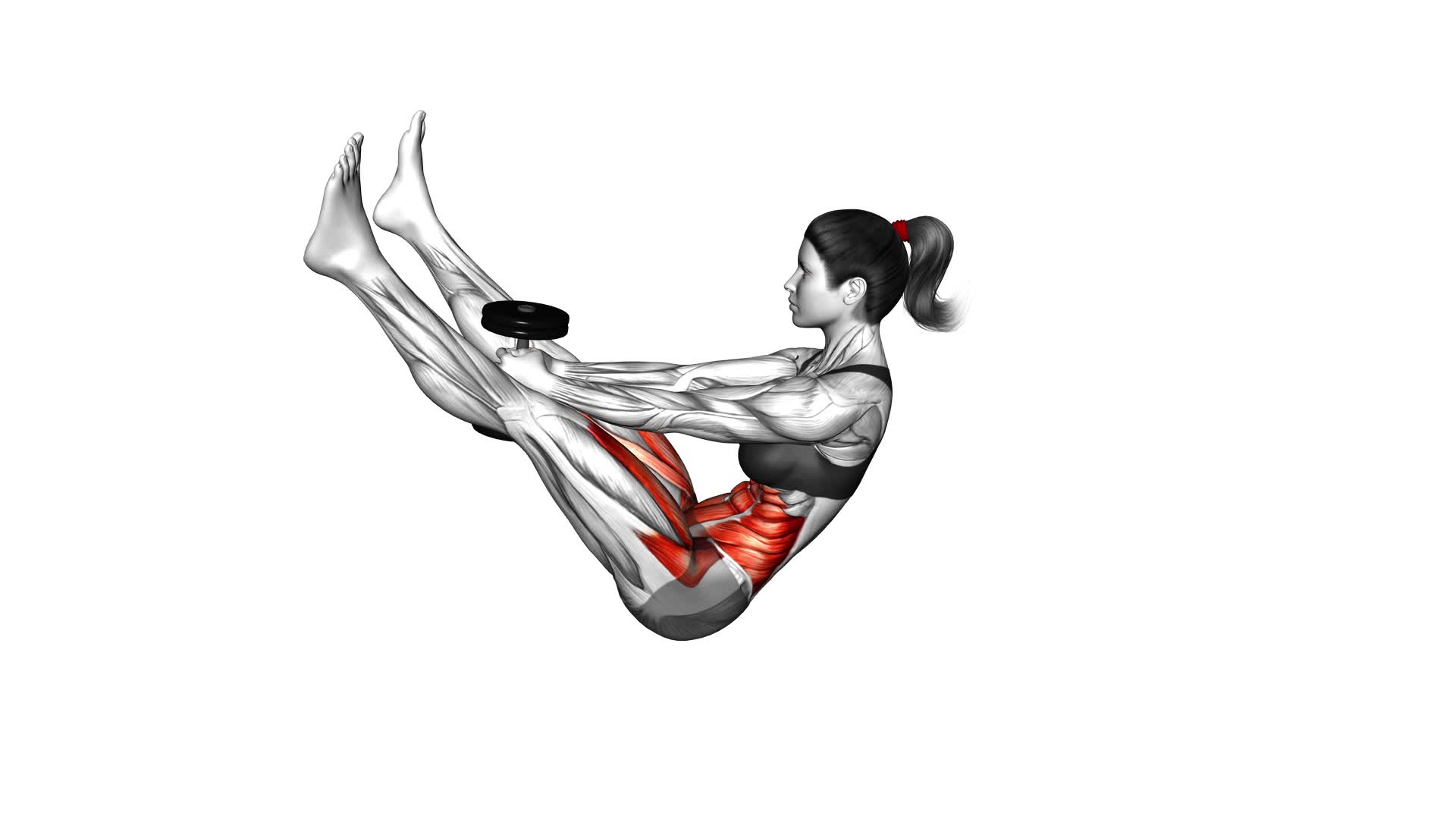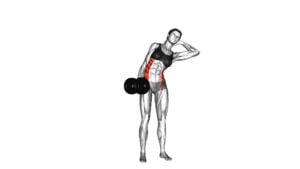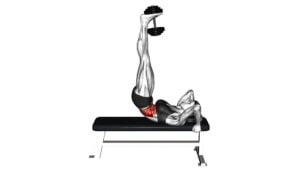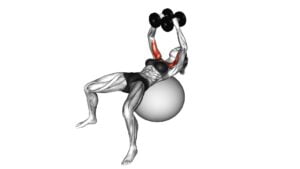Dumbbell V-up (female) – Video Exercise Guide & Tips

Are you looking for a challenging and effective exercise to target your core muscles? Look no further than the dumbbell v-up!
Watch This Exercise Video
This exercise is specifically designed for women, and our video exercise guide and tips will help you perform it correctly.
With just a few simple equipment requirements, you'll be on your way to a stronger core in no time.
Don't miss out on the variations and common mistakes to avoid – get the most out of your dumbbell v-up today!
Key Takeaways
- Dumbbell V-up provides a challenging exercise for the core, engaging multiple muscle groups simultaneously.
- Using dumbbells adds resistance, increasing the challenge and enhancing muscle development.
- Proper form and technique are essential to maximize the benefits of Dumbbell V-up and prevent injury.
- Alternatives to dumbbells such as resistance bands and medicine balls can be used for a similar effect.
Benefits of Dumbbell V-up for Women
You'll love the benefits you'll gain from incorporating dumbbell V-ups into your workout routine.
Not only do they provide a challenging exercise for your core, but they also engage multiple muscle groups simultaneously.
The primary benefit of dumbbell V-ups is the intense core engagement they offer. As you lift your legs and upper body off the ground, your abdominal muscles contract to stabilize your torso. This helps to strengthen your core and improve overall stability and balance.
Additionally, the use of dumbbells adds resistance, further increasing the challenge and enhancing muscle development.
By incorporating dumbbell V-ups into your routine, you can expect to see improvements in your core strength, stability, and overall athleticism. These benefits extend beyond just a toned midsection, as a strong core is essential for performing everyday activities and minimizing the risk of injury.
Now, let's move on to the equipment needed for dumbbell V-ups.
Equipment Needed for Dumbbell V-up
To perform the Dumbbell V-up exercise, you'll need some essential equipment. Firstly, you'll need a dumbbell of an appropriate weight for your fitness level. Make sure to choose a dumbbell that challenges you without compromising your form.
If you don't have access to dumbbells, there are alternatives you can use, such as water bottles or resistance bands.
Essential Equipment for V-Up
To perform the Dumbbell V-up exercise, you'll need a pair of dumbbells. Here are the essential equipment you'll need for this exercise:
- Best dumbbells: Choose dumbbells that are comfortable to hold and provide enough resistance for your fitness level. Opt for adjustable dumbbells if you want to vary the weight as you progress.
- Benefits of weighted exercises: Using dumbbells adds resistance to your V-up exercise, making it more challenging and effective. Weighted exercises help build strength and increase muscle tone, especially in your core muscles.
- Proper workout attire: Wear comfortable workout clothes and supportive shoes to ensure a safe and effective workout. This will allow you to move freely during the exercise without restrictions.
Now that you know the essential equipment needed for the Dumbbell V-up exercise, let's move on to the next section, where we'll guide you on choosing the right dumbbell for your fitness goals.
Choosing the Right Dumbbell
Now let's dive into selecting the right dumbbell for your Dumbbell V-up exercise, building upon the previous discussion on essential equipment.
Finding the right weight for your Dumbbell V-up is crucial to ensuring proper form and maximizing your workout. When it comes to dumbbell size selection, it's important to consider your fitness level and strength.
Beginners may want to start with lighter dumbbells, around 5-10 pounds, and gradually increase the weight as they become more comfortable and stronger. Intermediate and advanced individuals may opt for heavier dumbbells, ranging from 10-20 pounds or even more.
Alternatives to Dumbbells
If you don't have access to dumbbells, there are alternative equipment options you can use for the Dumbbell V-up exercise. Here are three effective substitutes:
- Resistance Bands: These bands provide variable resistance and can be used to mimic the resistance provided by dumbbells. Simply loop the band around your feet and hold the ends in your hands while performing the V-up motion.
- Medicine Ball: Holding a medicine ball between your feet can add extra resistance to the exercise. Choose a weight that challenges you but still allows you to maintain proper form throughout the movement.
- Kettlebell: Holding a kettlebell in both hands can also be a great alternative to dumbbells. The weight of the kettlebell will engage your core muscles as you perform the V-up motion.
Remember to choose equipment that challenges you, but still allows you to maintain proper form and technique for the Dumbbell V-up exercise.
Proper Form and Technique for Dumbbell V-up
How can you perform the Dumbbell V-up exercise with proper form and technique?
The Dumbbell V-up is a highly effective exercise that targets the abdominal muscles, specifically the rectus abdominis. To ensure you're getting the most out of this exercise, it's important to understand the proper form and technique.
First, lie flat on your back with your legs extended and your arms holding a dumbbell above your head. Engage your core muscles by pulling your belly button towards your spine. As you exhale, simultaneously lift your upper body and legs off the ground, bringing the dumbbell towards your toes. Keep your legs straight and try to touch the dumbbell to your toes. Pause for a moment at the top of the movement, then slowly lower yourself back down to the starting position.
To maximize the benefits of the Dumbbell V-up practice, it's crucial to maintain control throughout the exercise. Avoid using momentum or swinging your legs to lift your upper body. Instead, focus on using your abdominal muscles to initiate the movement. Additionally, be mindful of your breathing, exhaling as you lift your body and inhaling as you lower it back down.
Common mistakes to avoid in the Dumbbell V-up include lifting your shoulders off the ground too high, which can strain your neck and shoulders. It's also important to avoid arching your back or using your hip flexors to lift your legs. By maintaining proper form and technique, you can effectively target your abdominal muscles and prevent injury.
Variations of Dumbbell V-up for Progression
To progress the Dumbbell V-up exercise, you can incorporate variations by adding resistance or increasing the difficulty level. Here are three variations of the Dumbbell V-up that can help you progress in your fitness journey:
- Weighted Dumbbell V-up: Hold a dumbbell in both hands and extend your arms overhead. As you perform the V-up motion, keep the dumbbell stable and controlled. This added resistance will challenge your core muscles even more, helping you build strength and stability.
- Elevated Dumbbell V-up: Elevate your legs by placing them on a bench or stability ball. This variation increases the difficulty level by adding an element of instability, forcing your core muscles to work harder to maintain balance and control throughout the movement.
- Alternating Dumbbell V-up: Instead of lifting both legs at the same time, lift one leg while holding the dumbbell overhead, then alternate to the other leg. This variation engages your core muscles asymmetrically, providing a different challenge and helping to improve overall core strength and coordination.
Common Mistakes to Avoid During Dumbbell V-Up
To perform the dumbbell V-up correctly and avoid potential injuries, it's important to be aware of common mistakes.
One common mistake is using incorrect form, such as pulling with your neck instead of engaging your core muscles. This can lead to strain and discomfort.
Another mistake to avoid isn't fully engaging your core during the exercise, which can result in a less effective workout.
Incorrect Form Dangers
Avoid using too heavy dumbbells when performing the Dumbbell V-Up exercise to prevent potential incorrect form dangers. By maintaining proper form, you can reduce the risk of injuries and maximize the effectiveness of the exercise.
Here are three common mistakes to avoid:
- Arching your lower back: When lifting your legs and upper body off the ground, be mindful of keeping your lower back flat against the mat. Arching your back can strain the muscles and lead to discomfort or injury.
- Using momentum: Avoid swinging your arms and legs during the exercise. Instead, focus on controlled movements and engaging your core muscles to lift your body.
- Neglecting the mind-muscle connection: Stay present and focused during the exercise. Visualize your muscles working and concentrate on contracting your abs to achieve the best results.
Lack of Core Engagement
Engage your core muscles fully for optimal results during the Dumbbell V-Up exercise. Core strengthening is crucial for overall stability and proper form during this exercise. By neglecting to engage your core, you risk putting unnecessary strain on other muscle groups and increasing the chance of injury.
Your core muscles, including the abdominals, obliques, and lower back, play a vital role in maintaining balance and supporting your spine. It's important to focus on maintaining core stability throughout the entire movement of the Dumbbell V-Up. This won't only improve your performance but also help prevent back pain and improve your overall posture.
Tips for Getting the Most Out of Dumbbell V-Up
Maximize your results with the Dumbbell V-Up exercise by incorporating these tips:
- Use progression techniques: Start with a lighter dumbbell and gradually increase the weight as your strength improves. This will challenge your core muscles and help you progress towards more advanced variations of the exercise.
- Engage your core: To get the most out of the Dumbbell V-Up, focus on activating your core muscles throughout the entire movement. Keep your abs tight and your back straight as you lift your upper body and legs off the ground. This will ensure that your core is working hard and that you're getting a full range of motion in each rep.
- Maintain proper form: Pay attention to your form during the exercise. Keep your arms straight and your chest lifted as you reach for your toes with the dumbbell. Avoid using momentum and instead, rely on the strength of your core to lift your upper body and legs. This will help you target your abs effectively and prevent any unnecessary strain on your back.
Frequently Asked Questions
How Many Sets and Reps Should I Do for the Dumbbell V-Up Exercise?
To get the most out of the dumbbell V-up exercise, you need to focus on the number of sets and reps. It's important to find a balance between challenging yourself and maintaining proper form.
Start with 2-3 sets of 8-12 reps, with a rest period of 30-60 seconds between sets. If you're a beginner, you can modify the exercise by using lighter weights or by performing the movement without weights. Gradually increase the intensity as you get stronger.
Can Men Also Perform the Dumbbell V-Up Exercise?
Yes, men can also perform the dumbbell V-up exercise. It's a great way to target your core muscles and increase overall strength and stability.
By incorporating variations of the dumbbell V-up, such as adding more weight or increasing the number of reps, you can make the workout more challenging.
The benefits of incorporating this exercise into your fitness routine include improved core strength, enhanced abdominal muscles, and better posture.
Is It Necessary to Use Dumbbells for the Dumbbell V-Up Exercise?
No, it isn't necessary to use dumbbells for the dumbbell v-up exercise. There are alternative equipment options available, such as a medicine ball or a kettlebell, that can be used to add resistance to the exercise.
Additionally, beginners can modify the exercise by using lighter weights or no weights at all, focusing on proper form and gradually increasing the intensity as they progress.
Can I Perform the Dumbbell V-Up Exercise if I Have Lower Back Pain?
If you're experiencing lower back pain, it's important to be cautious when performing the dumbbell v-up exercise. Instead, consider alternative exercises that strengthen your core without straining your lower back. Plank variations, bird dogs, and modified crunches are great options.
Additionally, modifying the dumbbell v-up exercise can help prevent lower back pain. Try using lighter dumbbells or removing them altogether, focusing on proper form and engaging your core muscles.
Always listen to your body and consult a healthcare professional if needed.
How Long Should I Rest Between Sets When Performing the Dumbbell V-Up Exercise?
When performing the dumbbell v-up exercise, it's important to consider the rest periods between sets. Resting for about 30 to 60 seconds between sets can help you recover and maintain proper form. This allows your muscles to recharge and prepares you for the next set.
Incorporating rest periods into your routine ensures that you can perform the exercise effectively and safely. Additionally, the dumbbell v-up exercise offers numerous benefits, such as improving core strength and stability.
Conclusion
In conclusion, the dumbbell V-up is a beneficial exercise for women looking to strengthen their core and improve overall body strength. By incorporating dumbbells into this exercise, women can increase the intensity and challenge their muscles even further.
Remember to maintain proper form and technique to avoid injury and maximize results. With variations available for progression and common mistakes to avoid, women can effectively target their abdominal muscles and achieve their fitness goals.
Follow these tips to get the most out of your dumbbell V-up routine.

Author
Years ago, the spark of my life’s passion ignited in my mind the moment I stepped into the local gym for the first time. The inaugural bead of perspiration, the initial endeavor, the very first surge of endorphins, and a sense of pride that washed over me post-workout marked the beginning of my deep-seated interest in strength sports, fitness, and sports nutrition. This very curiosity blossomed rapidly into a profound fascination, propelling me to earn a Master’s degree in Physical Education from the Academy of Physical Education in Krakow, followed by a Sports Manager diploma from the Jagiellonian University. My journey of growth led me to gain more specialized qualifications, such as being a certified personal trainer with a focus on sports dietetics, a lifeguard, and an instructor for wellness and corrective gymnastics. Theoretical knowledge paired seamlessly with practical experience, reinforcing my belief that the transformation of individuals under my guidance was also a reflection of my personal growth. This belief holds true even today. Each day, I strive to push the boundaries and explore new realms. These realms gently elevate me to greater heights. The unique combination of passion for my field and the continuous quest for growth fuels my drive to break new ground.







